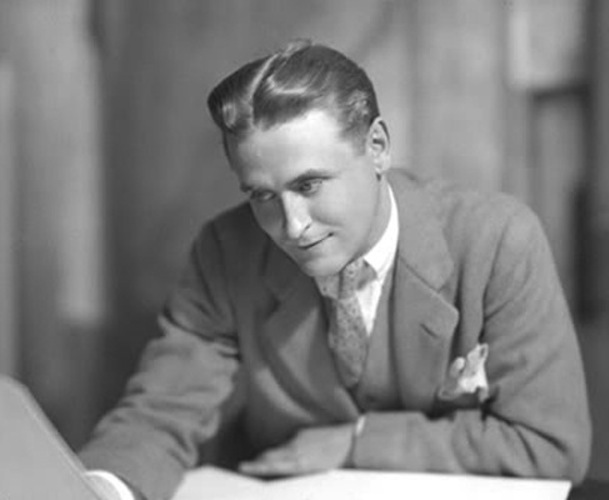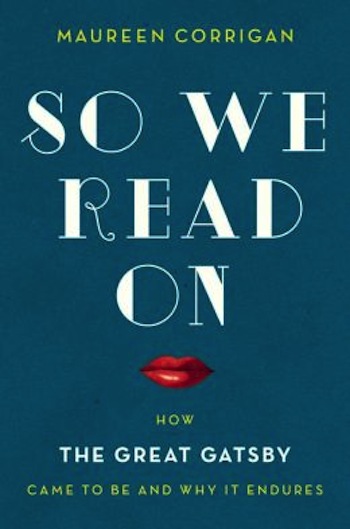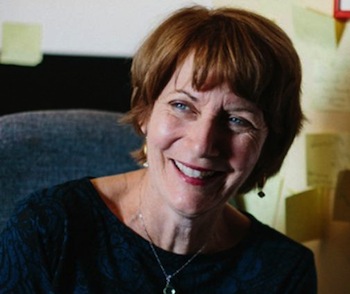Book Review: “The Great Gatsby” — The Greatest American Novel?
There’s no debate: The Great Gatsby is the Great American Novel, with Moby Dick and Huckleberry Finn as also-rans.
By Gerald Peary
Like a Jesus freak mooing over the Holy Scriptures, Maureen Corrigan, the long-time NPR book critic, has gone orgastic (a choice F. Scott Fitzgerald word) about The Great Gatsby. It’s the book. There’s no debate: it’s the Great American Novel, with Moby Dick and Huckleberry Finn as also-rans. And unlike Moby Dick and Huckleberry Finn and, 20th century canonic favorites, The Invisible Man and Beloved and Their Eyes Were Watching God and To Kill a Mockingbird, it foregrounds class issues instead of racial ones. In fact, you can’t read a finer novel about class than Fitzgerald’s Gatsby.
As for the best book ever exploring the efficacies of The American Dream? It’s Gatsby again, raved about in Corrigan’s spirited, engaging So We Read On-How The Great Gatsby Came To Be and Why It Endures (Little, Brown, $26). Corrigan: “That’s what I think about Gatsby; it’s the only undisputed masterpiece that F. Scott Fitzgerald, who died at the age of forty-four, lived to write, and it’s as perfect as a novel can be.”
But what if you aren’t a true believer? Nick Carraway has left you cold, and you don’t give a damn about Tom and Daisy Buchanan? I understand, Corrigan says, attesting to her own indifference to Gatsby when it was an assignment in high school. Just read it again. And then again. It just gets better and deeper and more profound, and you will be hooked. That’s the promise of the blissed-out author who has made her way through the book “upwards of fifty times,” lectured yearly about it in her English courses at Georgetown University, and spoken up for it in countless ways and countless situations across America.
I agree with Corrigan, based on my own modest three readings. The first time at 15, it was a pretty good Gatsby at best, not important to me like, say, The Catcher in the Rye, A Separate Peace, or Look Homeward, Angel. The second time, as a young adult, a good Gatsby, but hardly a favorite. Recently, the wonderfulness shined through, during a snail-slow, year-long reading out loud of the book to my wife. The Great Gatsby indeed!
But why bother with Corrigan when there are some thirty-odd biographies of Fitzgerald and an infinite run of analyses of The Great Gatsby? Because So We Read On is, next to all those sober works, the fun tome, intellectually playful and informal and so winning in Corrigan’s cheerleader enthusiasm. And so appropriately biographical and personal. Her obsession with Gatsby has a geographic tie-in. As a girl growing up in Sunnyside Queens, she took the same roads on weekends as the wealthy of The Great Gatsby but heading the opposite way. While Tom Buchanan and Jay Gatsby drove into New York City from East Egg, Corrigan and her parents took their Nash Rambler out to gawk at the great mansions spread out on coastal Long Island. They were lower-middle-class Irish, who would make “the return trip to Sunnyside, where we belonged… The weekend was over, school was looming, and we would be cooped up in our small, dark apartment.”
Corrigan worked hard, went Ivy League to Penn, and now manages the enviable twin jobs–the American Dream?– of critiquing for Public Radio and teaching at elite Georgetown. But she’s kept close her outsider childhood, being from the loser side of the track. She can’t help but root for arriviste Jay Gatsby, who, despite his power and possessions, can never match up to Tom and Daisy with their old-money breeding. Tom ridicules Gatsby: “Mr. Nobody from Nowhere.” Corrigan relates to him: “[H]e’s always stuck in the car with the Corrigans-always on the outside looking in. The rich are different from you and me.”
And Corrigan can’t help but feel for F. Scott Fitzgerald himself, whose family in Minnesota was never quite moneyed enough, not quite patrician enough. The deeply sensitive author suffered a lifetime of trying to fit in with the best and wealthiest while also feeling a hatred for their unfair, unearned advantage. Fitzgerald in a 1938 letter: “That was always my experience-a poor boy in a rich town, a poor boy in a rich boy’s school; a poor boy in a rich man’s club at Princeton…I have never been able to forgive the rich for being rich, and it has colored my whole life.”
In a far more excitable way than the formal biographies, Corrigan is a tour guide to Fitzgerald’s life and to how it related to the writing of Gatsby. She offers up the various real-life candidates who might have been the models for Daisy, Tom, Jay, and the rest of the ensemble (i.e. Edith Cummings, a golfer who was a 1922 Time cover girl, as the inspiration for Jordan Baker). She speaks of Fitzgerald’s living himself the high Nick Carraway life on Long Island, he and the equally inebriated Ring Lardner peering across the water to Manhasset Bay, checking out the Jay Gatsby-like lawn parties of New York World publisher, Herbert Bayard Swope.
Occasionally, Corrigan does move away from Gatsby to discuss other parts of Fitzgerald’s life: Zelda, of course, and how they met, courted, married, and self-consciously dramatized their Jazz Age personas. But even here, Gatsby reenters: while Scott wrote in their apartment, Zelda seemed to have an affair on the beaches of Southern France. How did that tryst, Corrigan asks, affect all the extra-marital liaisons which pepper The Great Gatsby?
Did I mention that Maureen Corrigan loves The Great Gatsby? Her adoration makes her curiously indifferent to Fitzgerald’s other novels. She finds This Side of Paradise an overrated piece of almost juvenilia, and simply skips over The Beautiful and the Damned. And she admits freely that Tender is the Night, even with its beautiful passages of writing, doesn’t do it for her like Gatsby. Hmmm. Maybe she needs to read Tender is the Night again and again?
OK, let’s get to Corrigan’s one woeful chapter, “Rhapsody in Noir,” in which she tries to claim, in a dozen misguided ways, why The Great Gatsby is, with its killings and gangster characters, an early “noir” novel. Wrong! There is nothing even slightly “noir,” slightly Black Mask, about the tone, characters, milieu of The Great Gatsby. The comparisons that Corrigan makes with Hammett and Chandler, whose books came out long after Gatsby, are strained and absurd. And here is where I caught Corrigan with a mistake, albeit a minor one. She asserts that in Chandler’s The Big Sleep, “Philip Marlowe and the other tough guys consistently address each other as ‘soldier.’” Actually, the only character who uses this phrase is gambler Eddie Mars, aimed derisively at Marlowe.

F. Scott Fitzgerald — the author of the Great American Novel. Roll over Melville, tell Twain the news.
Anyway, Corrigan regained my trust with subsequent chapters of So We Read On
.
There’s an amusing tourist trip by boat with her husband and daughter to see from afar the Gatsby sites on Long Island. Corrigan recalls an inept guide perusing her notes, trying to remember where Fitzgerald was born: “I want to say Minnesota.”
And there’s a heartfelt homage to the late Matthew Bruccoli, crusty and difficult, who has done more than anyone since the 1970s in producing scholarly writings on Fitzgerald, including a major biography.
Corrigan also makes a most important contribution to Fitzgerald scholarship. It’s her intrepid detective sleuthing to trace how The Great Gatsby, out of print and truly forgotten at the time of Fitzgerald’s death in 1940, slowly returned to circulation, and gradually emerged from obscurity to its reputation as an American masterpiece. Corrigan describes a perfect storm of well-circulated paperback reprints in the 1940s, the posthumous publication of Fitzgerald’s The Crack-up and The Last Tycoon, the stalwart support of major luminaries like Edmund Wilson and the legendary editor, Maxwell Perkins, the advent of movie and television adaptations of Gatsby, the publication of Budd Schulberg’s great Fitzgerald-based novel, The Disenchanted, and the popular success of gossip columnist Sheilah Graham’s appealing memoirs of her love relationship with Fitzgerald, Beloved Infidel and College of One.
A movie version of the former with Gregory Peck as Scott surely helped romanticize the writer. Finally, the biographies started popping out regularly, starting with Arthur Mizener’s 1951 The Far Side of Paradise, informing the world of Scott and Zelda’s doomed, excessive, extraordinary relationship. In fact, Corrigan has crowned 1951 as “the crucial Fitzgerald Revival year.” She quotes, also from 1951, the gospel according to Holden Caulfield in The Catcher in the Rye. “I was crazy about The Great Gatsby,” Holden testified. “Old Gatsby. Old Sport. That killed me.”
Gerald Peary is a professor at Suffolk University, Boston, curator of the Boston University Cinematheque, and the general editor of the “Conversations with Filmmakers” series from the University Press of Mississippi. A critic for the late Boston Phoenix, he is the author of 9 books on cinema, writer-director of the documentary For the Love of Movies: the Story of American Film Criticism, and a featured actor in the 2013 independent narrative Computer Chess


